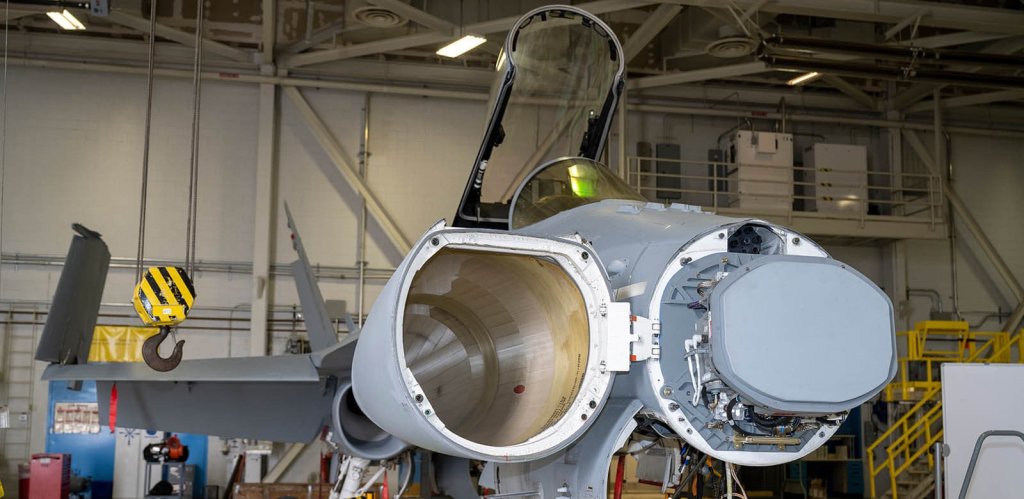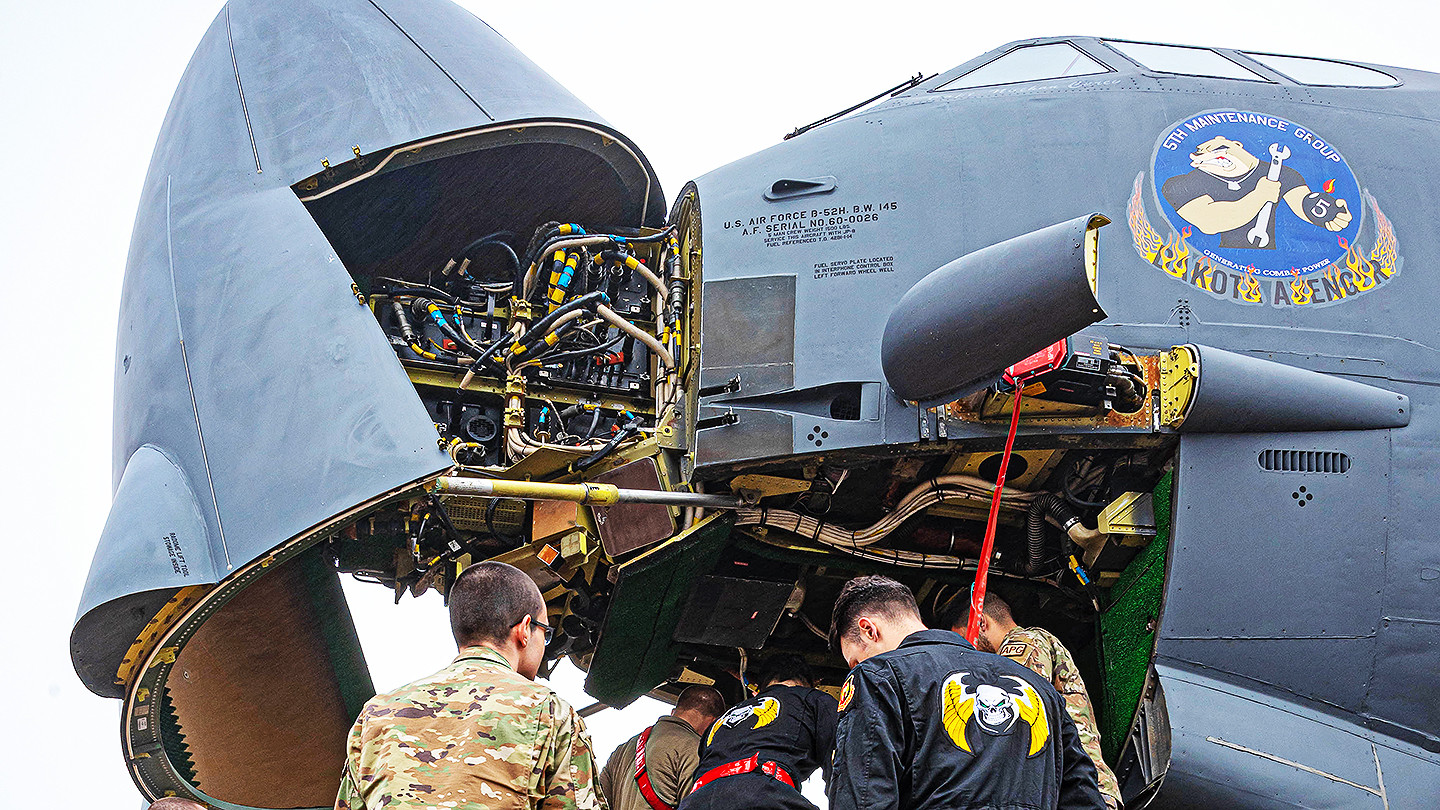The U.S. Air Force office responsible for the B-52 Radar Modernization Program (RMP) is asking for new information about options for derivatives of off-the-shelf multi-mode radars that could go into the bombers. At the same time, the service insists there has been no change to the current RMP plan to integrate a new Raytheon active electronically scanned array (AESA) radar primarily derived from the AN/APG-79 onto its B-52s, an effort that has suffered from delays and cost growth.
In 2019, Boeing selected Raytheon to supply the radar for the B-52 RMP. Raytheon (now formally known as RTX) delivered the first of these radars, known as the AN/APQ-188 Bomber Modernized Radar System, to Boeing in 2023. The plan, as it stands now, is to replace the Cold War-era mechanically scanned AN/APQ-166 radars in each of the 76 B-52Hs in service now. The Air Force has said in the past that it is hoping to reach initial operational capability (IOC) with B-52s with new radars in Fiscal Year 2027. This is all part of a larger modernization effort for the B-52 fleet that includes new engines and other upgrades. The resulting bombers, which are set to keep flying in the 2050s, will be redesignated as B-52Js.

“The B-52 RMP Program Office is conducting market research to identify parties having the capabilities to produce a modified off the shelf multi-mode radar compatible with the B-52 for the USAF,” an Air Force contracting notice first posted online on March 19 states. “The acquisition strategy has not yet been determined. Market research results will assist the Air Force in determining whether this requirement will be a full and open, a small business set-aside, or a sole source acquisition. This is an INDUSTRY NOTIFICATION and is for INFORMATIONAL PURPOSES ONLY. This is not a solicitation.”
“The Air Force continually assesses a range of alternate solutions to requirements as technology matures and/or operational conditions may drive changes to requirements,” an Air Force spokesperson told TWZ when asked for additional information and clarification about what this contracting notice might mean for the B-52 RMP plan.
“This notice was a source sought intended to inform the SAE [Senior Acquisition Executive] as to the range of radar options available for rapid fielding,” the spokesperson added. “There is currently no planned change to the B-52 RMP plan.”
In general, AESA radars offer greater range, fidelity, and resistance to countermeasures, as well as the ability to provide better overall general situational awareness, compared to mechanically scanned types. Increasingly advanced AESAs bring additional capabilities, including electronic warfare and communications support.

For the B-52, any new multi-mode AESA will improve the bomber’s target acquisition and identification capabilities, including when used together with targeting pods available for the bombers now. New radars for the bombers will also be helpful when it comes to guiding networked weapons over long distances to their targets and could provide a secondary ground moving target indicator (GMTI) and synthetic aperture radar surveillance capabilities. The radar upgrade could help defend B-52s from air-to-air threats, including through improved detection of incoming hostile aircraft.
The recent contracting notice can only raise questions about the B-52 RMP status and future, despite the Air Force’s statement that the plan remains unchanged, at least for now. The AN/APQ-188 is leveraging a proven design, the AN/APG-79, versions that are already in use on the F/A-18E/F Super Hornet and EA-18G Growler, as well as the upgraded legacy F/A-18 Hornets for the U.S. Marine Corps. It is also incorporating technology from the AN/APG-82 found on Air Force F-15E Strike Eagle and F-15EX Eagle II combat jets.

“The program [B-52 RMP] completed Critical Design Review in February 2022. The Air Force continues to refine the system radome design to address aircraft integration issues. Depending on [the] final radome design, radar performance may be impacted,” the Pentagon’s Office of the Director of Test and Evaluation (DOT&E) warned in its most recent annual report covering work on various programs in the 2024 Fiscal Year, which ended Sept. 30 of last year.
“The program office should fully characterize performance with the final radome design to inform operational employment tactics. Modification of test aircraft and development of [the] initial system flight software began in FY23 [Fiscal Year 2023],” that report added. “Delays related to integration challenges have shifted the planned start of developmental and integrated flight testing to FY26, leading to IOT&E [initial operational test and evaluation] in FY28.”
DOT&E’s report also said that a decision on whether to proceed with integration of the new AN/APQ-188 on the first 28 B-52Hs is expected to come in Fiscal Year 2026, roughly two years later than originally planned. Work to install the improved radars on the remaining bombers might not start until Fiscal Year 2028.
“Exact dates are uncertain due to technical and schedule risks,” DOT&E noted.

Last year, a separate report from the Government Accountability Office, a Congressional watchdog, disclosed that the B-52’s RMP’s total estimated price tag had risen from $2.343 billion ($1.327 billion in developmental costs and another $1.015 billion in procurement costs) in 2021 to $2.580 billion ($1.437 billion and $1.143 billion for development and procurement, respectively) in 2023. Based on those total program costs, the price to upgrade each of the 76 B-52s rose from $30.8 million to $33.9 million. When the GAO’s report came out in June 2024, the Air Force was also expected to have a further revised cost estimate by this month, but it is unclear whether or not that has occurred.
There are certainly several potential alternatives to the AN/APQ-188 that could fit inside the B-52’s nose on the open market now. Before Raytheon was selected to provide the radar for the B-52 RMP, TWZ highlighted Northrop Grumman’s AN/APG-83, also known as the Scalable Agile Beam Radar (SABR), or a variant or derivative thereof, as one particularly notable option. SABR, which is in large-scale production and is seen as an affordable upgrade option for various platforms, is in service on an increasing number of Air Force F-16s, as well as examples of that fighter in service globally. The EL/M-2032 from Israel’s Elta and the Vixen series from Leonardo in Italy are also growing in popularity.

Any major changes to the B-52 RMP at this stage would run the risk of additional delays and cost growth, as well.
The separate B-52 re-enging effort, also known as the Commercial Engine Replacement Program (CERP), has also been beset by delays and growing costs. Bombers with the new engines, which are set to help reduce operating and maintenance costs, as well as significantly extend the unrefueled range of the aircraft, may not begin flying operational missions until 2033.
Whether or not the Air Force ultimately changes its plans for the B-52 RMP, the service is clearly making sure it knows all of its options.
Contact the author: joe@twz.com
